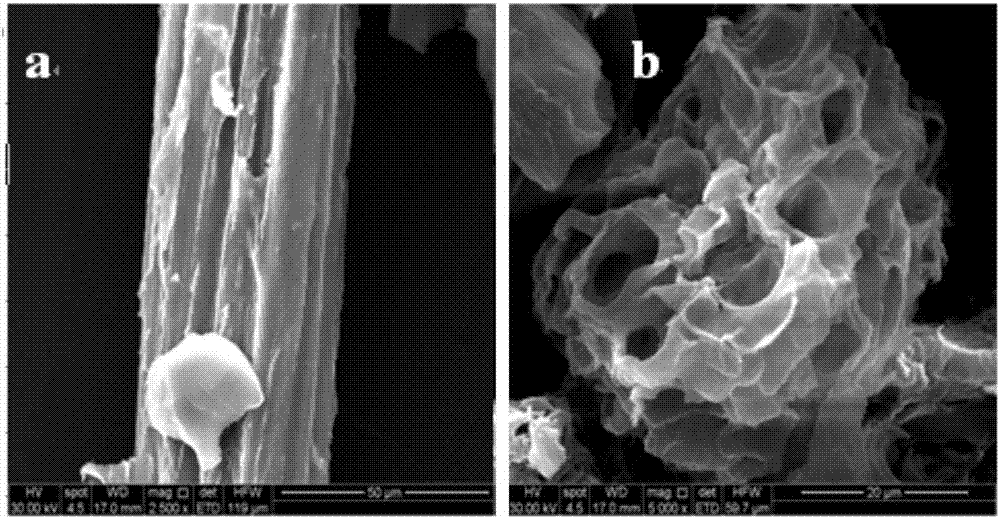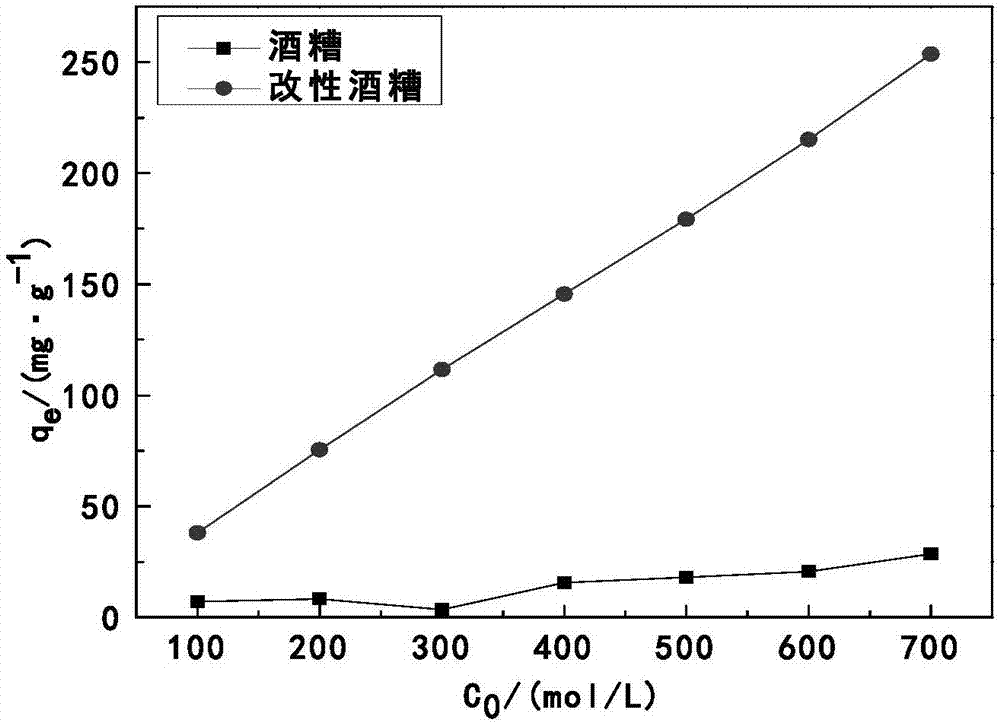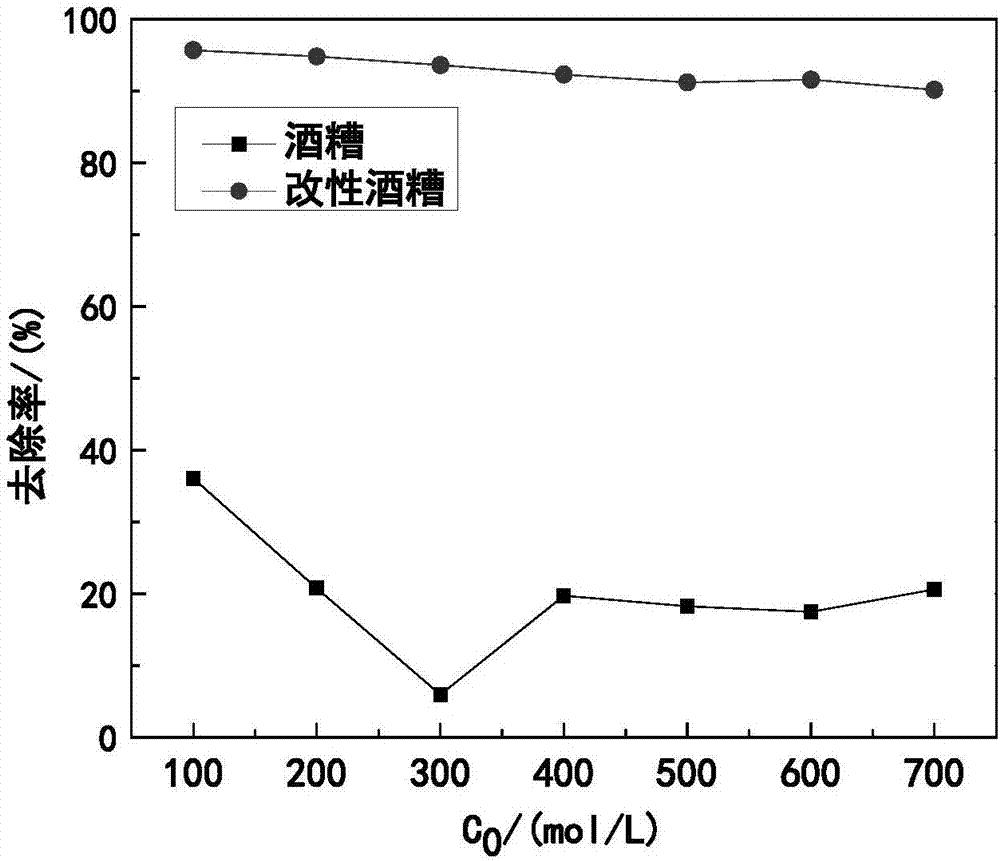Amphoteric adsorbent prepared from grain stillage, preparation method for amphoteric adsorbent and application of amphoteric adsorbent
A technology of adsorbent and distiller's grains, which is applied in the field of brewing waste resource utilization and environmental protection, can solve the problems of polluting the environment and wasting resources, and achieves the effects of low reaction energy consumption, increased adsorption capacity and adsorption rate, and wide source of raw materials
- Summary
- Abstract
- Description
- Claims
- Application Information
AI Technical Summary
Problems solved by technology
Method used
Image
Examples
Embodiment 1
[0032] A method for an amphoteric adsorbent prepared from distiller's grains, comprising the following steps:
[0033] 1) In terms of parts by mass, add 5 parts of potassium hydroxide to 50 parts of deionized water to obtain the first lye, cool to room temperature for subsequent use; add 1 part of sodium hydroxide to 50 parts of In deionized water, the second lye was obtained, cooled to room temperature for later use; adding 1 part of magnesium nitrate to 1 part of deionized water according to the mass ratio to obtain a magnesium nitrate solution, cooled to room temperature for later use.
[0034] 2) In terms of parts by mass, add 1 part of 20-mesh distiller's grains to 1 part of the first lye, stir at 20°C and 60r / min for 0.5h, wash with deionized water twice until neutral, Dry at 30°C to obtain pretreated distiller's grains.
[0035] 3) In terms of parts by mass, add 1 part of pretreated distiller's grains to 1 part of the second lye, stir at 20°C and 60r / min for 0.1h, add ...
Embodiment 2
[0038] A method for an amphoteric adsorbent prepared from distiller's grains, comprising the following steps:
[0039] 1) In terms of parts by mass, add 10 parts of sodium carbonate to 100 parts of deionized water to obtain the first lye, cool to room temperature for subsequent use; add 5 parts of potassium hydroxide to 250 parts of deionized water by mass ratio In deionized water, the second lye was obtained, cooled to room temperature for later use; 5 parts of magnesium chloride were added to 5 parts of deionized water according to the mass ratio to obtain a magnesium chloride solution, cooled to room temperature for later use.
[0040] 2) In terms of parts by mass, add 6 parts of 80-mesh yellow rice distiller's grains to 7 parts of the first lye, stir at 30°C and 80r / min for 1.5h, wash with deionized water 3 times until neutral, and Dry at 45°C to obtain pretreated distiller's grains.
[0041] 3) In parts by mass, add 3 parts of pretreated distiller's grains to 4 parts of ...
Embodiment 3
[0044] A method for an amphoteric adsorbent prepared from distiller's grains, comprising the following steps:
[0045] 1) In terms of parts by mass, add 20 parts of sodium hydroxide to 200 parts of deionized water to obtain the first lye, cool to room temperature for subsequent use; add 15 parts of sodium bicarbonate to 300 parts of In deionized water, the second lye was obtained, cooled to room temperature for later use; adding 10 parts of zinc chloride to 100 parts of deionized water according to the mass ratio to obtain a zinc chloride solution, cooled to room temperature for later use.
[0046] 2) In terms of parts by mass, add 12 parts of 150-mesh distiller's grains to 14 parts of the first lye, stir at 40°C and 140r / min for 3 hours, wash with deionized water 5 times until neutral, and and then dried to obtain pretreated distiller's grains.
[0047] 3) In terms of parts by mass, add 12 parts of pretreated distiller's grains to 14 parts of the second lye, stir at 40°C and...
PUM
| Property | Measurement | Unit |
|---|---|---|
| Maximum adsorption capacity | aaaaa | aaaaa |
| Adsorption capacity | aaaaa | aaaaa |
| Adsorption capacity | aaaaa | aaaaa |
Abstract
Description
Claims
Application Information
 Login to View More
Login to View More - R&D
- Intellectual Property
- Life Sciences
- Materials
- Tech Scout
- Unparalleled Data Quality
- Higher Quality Content
- 60% Fewer Hallucinations
Browse by: Latest US Patents, China's latest patents, Technical Efficacy Thesaurus, Application Domain, Technology Topic, Popular Technical Reports.
© 2025 PatSnap. All rights reserved.Legal|Privacy policy|Modern Slavery Act Transparency Statement|Sitemap|About US| Contact US: help@patsnap.com



